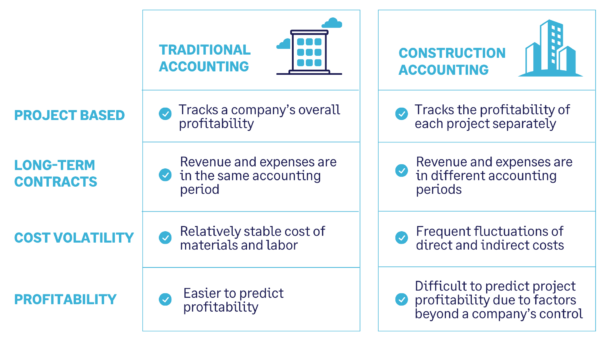Why Accurate Construction Accounting Is Critical for Large-Scale Projects
Why Accurate Construction Accounting Is Critical for Large-Scale Projects
Blog Article
A Comprehensive Guide to Building Accountancy: Optimize Your Financial Administration
Reliable financial administration is important in the building and construction sector, where the intricacies of project-based profits and expenditures can substantially affect total profitability. By utilizing best practices in financial reporting and evaluation, stakeholders can not only enhance operational efficiency yet likewise minimize possible dangers.
Understanding Building And Construction Audit
Comprehending building and construction audit is important for the effective administration of monetary sources in the building and construction industry. This specific branch of audit addresses the special challenges dealt with by construction companies, including project-based income acknowledgment, cost monitoring, and compliance with regulative demands. Unlike conventional bookkeeping, construction accountancy calls for a distinct method to manage the intricacies related to long-lasting agreements and rising and fall expenses.
Key parts of building and construction bookkeeping include exact earnings recognition, which usually counts on the percentage-of-completion technique or completed-contract approach, depending upon the task's nature. This makes certain that monetary declarations show true performance and productivity with time. Moreover, task costing plays a necessary duty, permitting companies to track expenditures related to particular tasks, which assists in figuring out profitability and resource appropriation.
Another essential aspect is the administration of money circulation, which is usually impacted by payment timetables and hold-ups in receivables. Reliable cash flow management guarantees that building firms can fulfill operational demands and purchase future tasks. Eventually, mastering building audit outfits companies with the devices necessary to make enlightened monetary choices, mitigate risks, and enhance general functional performance in an affordable market.

Task Costing and Budgeting
Job setting you back and budgeting are essential elements of construction audit that allow firms to properly take care of job financial resources and guarantee success. Work setting you back includes the careful monitoring of all expenses connected with a specific task, consisting of labor, materials, devices, and overhead. This procedure allows building companies to ascertain truth cost of finishing a job, helping with notified decision-making and improving financial responsibility.
Budgeting, on the other hand, functions as a financial roadmap for projects. It includes setting monetary limits and designating resources to numerous project elements, consequently developing a structure against which real prices can be gauged. Reliable budgeting requires comprehensive evaluation and projecting, thinking about historic data, market trends, and possible dangers.
Together, job setting you back and budgeting supply the necessary devices for building companies to keep track of economic efficiency, determine differences, and adjust methods as needed - construction accounting. By implementing robust task setting you back techniques and adhering to well-structured budget plans, firms can improve their operational efficiency, mitigate monetary risks, and ultimately enhance their profitability in an affordable marketplace. Thus, these practices are crucial for maintaining long-lasting success within the building and construction industry
Monitoring Expenses and Income
Properly tracking costs and income is essential for construction firms to preserve monetary wellness and ensure project practicality. Effective monitoring permits companies to keep an eye on task efficiency, identify price overruns, and make educated monetary choices. Carrying out a methodical strategy to recording all monetary deals is crucial to attaining this goal.
Utilizing building accounting software program can dramatically enhance the tracking process. These tools help with real-time surveillance of costs, consisting of labor, materials, and subcontractor costs, while also catching revenue generated from job turning points and customer payments. By classifying expenditures and profits streams, firms can gain understandings into profitability and capital.

Financial Coverage and Evaluation
Economic reporting and evaluation play a critical role in the building and construction sector, offering stakeholders with vital insights right into a firm's economic efficiency and functional performance. Exact monetary reports, including balance sheets, income statements, and capital declarations, are basic for evaluating the health and wellness of a building organization. These records aid identify patterns, review task profitability, and facilitate informed decision-making.
In construction accounting, monetary analysis goes past plain reporting; it includes looking at economic information to reveal underlying patterns and abnormalities. Secret performance indications (KPIs), such as gross profit margins, task conclusion prices, and return on investment, work as criteria to evaluate functional success. Routinely evaluating these metrics permits companies to recognize areas requiring improvement, maximize source appropriation, and boost project management methods.
Moreover, reliable monetary reporting promotes transparency and develops trust with stakeholders, including clients, vendors, and investors - construction accounting. By keeping extensive monetary oversight, building and construction firms can reduce dangers, make sure compliance with regulatory requirements, and inevitably drive lasting development. Thus, a durable economic reporting and analysis structure is crucial for navigating the complexities of the construction landscape and attaining long-term success
Ideal Practices for Success
To attain success in construction accountancy, business have to adopt a set of ideal practices that enhance operations and enhance economic monitoring. Applying a robust project monitoring software application customized for building can facilitate real-time monitoring of job costs and spending plans, enabling for even more exact projecting More about the author and resource allocation.
2nd, adopting a regular method to work setting you back is essential. This entails carefully tracking all prices connected with each job, consisting of labor, materials, and expenses. On a regular basis evaluating task prices against preliminary price quotes helps determine differences early, allowing timely restorative activities.
Third, keeping strenuous documentation practices makes sure compliance with laws and streamlines audits. This consists of keeping detailed records of contracts, modification orders, billings, and invoices.
Additionally, buying personnel training is necessary. Making certain that employees are well-versed in accounting principles, software usage, and market requirements can dramatically boost performance and precision in economic coverage.
Final Thought

Report this page